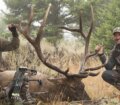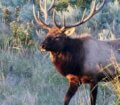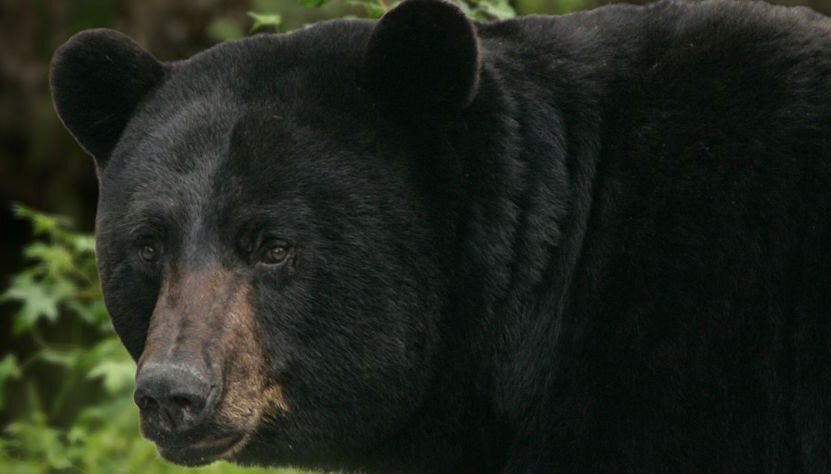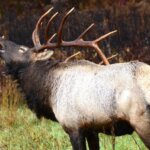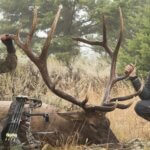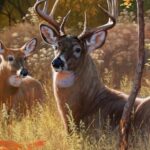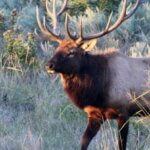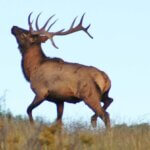Editor’s Note: Outdoorsman Bear Kelly was mentored as a trapper in 1996 by the late Dick Kirby, the creator of Quaker Boy Calls in Orchard Park, New York. Bear is primarily a bowhunter, but he hunts with a gun, a muzzleloader, and a crossbow. He’s hunted in Montana, Wyoming, Colorado, New York, Ohio, Pennsylvania, Alabama, Tennessee, and Canada.
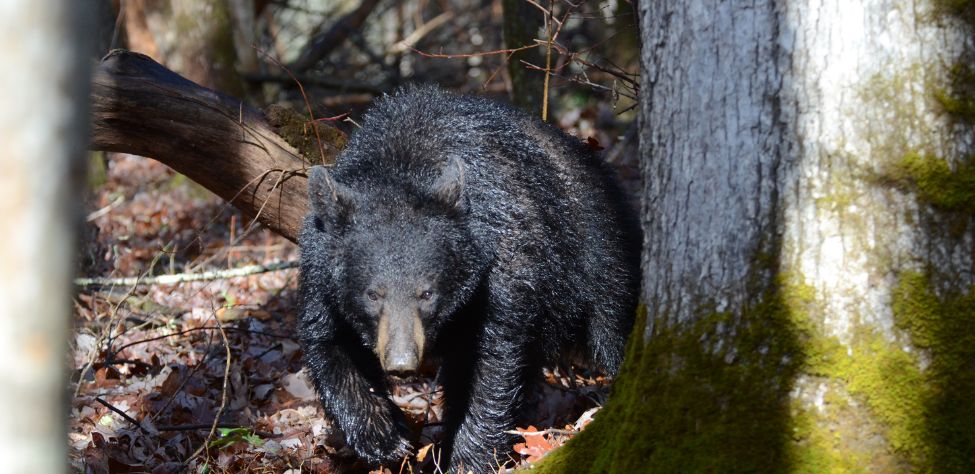
My best black bear weighed 420 pounds, but the size of the bear wasn’t nearly as big a deal as I was with Jack Coad. We went to Quebec, Canada, for a do-it-yourself bear hunt. The outfitter had put out stands and given each of us a map of the stand location. We would drive to the location of the stand and then walk into the stand to hunt. Jack and I would get up early each day and hunt until about 11:00 a.m., drive back to camp, eat lunch, nap, and return in the afternoon. Daylight lasts longer in Canada than in the States, so we’d hunt until black dark.
We often didn’t hunt from the stand the outfitter had put up because we were bowhunting and quickly saw that the stands were set up for rifle hunters. We might take our Summit tree stands, go up the tree where the outfitter put his stand, and then place our Summit tree stands 6-10 feet above the outfitter’s stand. We’d learned over the years that when a bear came in, he’d often look at the outfitter stand to see if a person was there, but by our being in a higher, second stand, he wouldn’t see us. When you hunt with a bow, you want to be much closer to where the bear is coming in than a gun bear hunter would want to be.
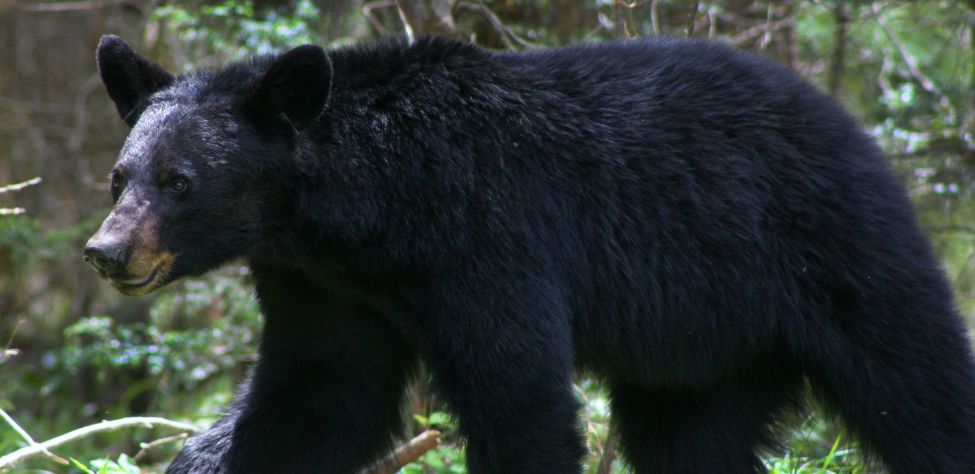
We wanted to set up within 15-18 yards of where the bear should be. Jack and I had planned this hunt to determine how effective Camo was. So, before the hunt, we decided that I would sit on the ground in between several bear trails and a ground blind. Jack planned to be up in a tree with a walkie-talkie and a range finder to tell me when a bear was coming in and give me the range that the bear was from me as it kept moving toward me. I had a small earbud with the volume turned down so I could hear Jack, but not loud enough to spook the bear. Jack would say, “Bear 50 yards, 40 yards, 30 yards,” so when the bear was close enough, I’d know the distance from me. On this hunt, I used a Parker crossbow with a scope on it and had a Wasp broadhead on my bolt (arrow).
We had planned our hunt for the worst-case scenario, which would be a female bear with cubs because those bears would most likely attack anything that they believed posed a danger to the cubs. So, I brought a .416 Rigby rifle in the blind with me. I planned to shoot the .416 in the air to scare the momma bear and cubs off before they got close to me. This hunt was the biggest thrill I’d ever had hunting, and I got hit with the most significant charge of adrenaline that I’d ever felt. I was sitting in a Summit trophy chair, and even though I was sitting on the ground, that Summit chair gave me a backrest that allowed me to sit comfortably longer.
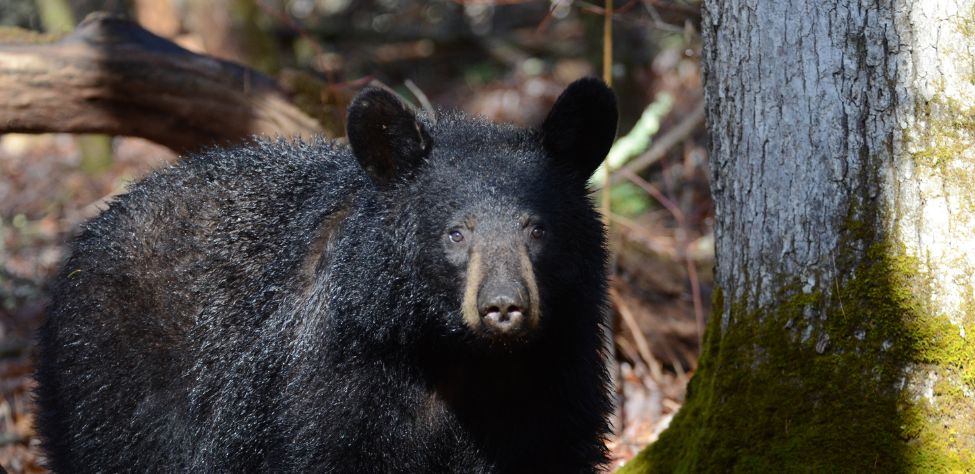
Once we were all set up, after a while, Jack said, “Bear,” and I heard him in my earbud. When I saw the bear, it was looking toward Jack. While watching the bear watching Jack, I heard another bear popping his jaws behind that bear. I hadn’t prepared for two bears so near my ground blind. I assumed that the bear popping his jaws was more significant than the bear in front of me, and I hadn’t planned for anything like that to happen. So, I quickly assumed that the bear before me was not the giant.
I picked up my crossbow and decided my best option was to shoot the bear in front of me at 5 yards. I got the crossbow to my shoulder and looked through my scope. But I could see nothing but black. The black reticles in the crossbow vanished when I looked at the black bear in front of me at 5 yards, and I couldn’t see where to aim, although I kept looking for some telltale sign on the bear that would give me a reference point to shoot. But I couldn’t find one. Then, my head started playing a game of mental gymnastics. I thought, “I’ve got this bear five yards in front of me that I can’t see where to shoot, and I’ve got a bigger bear upset and popping his jaw coming toward me.”
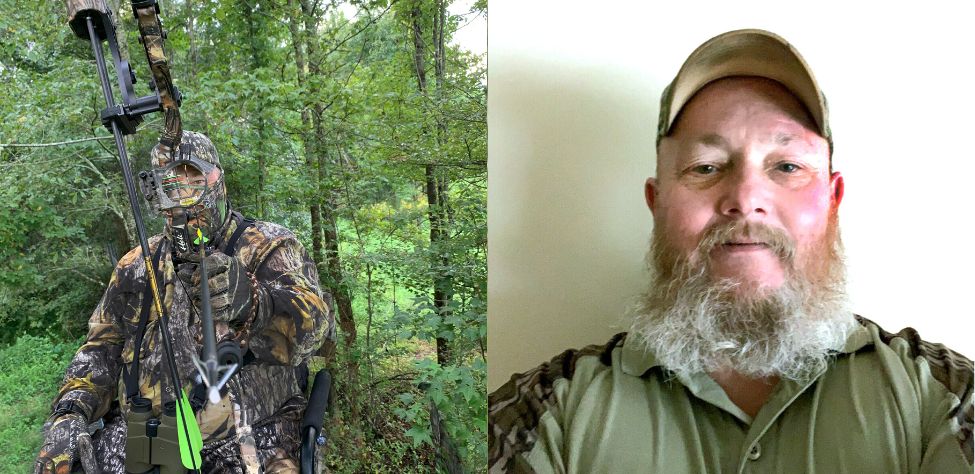
Once I spotted the bear that was popping his jaws, he was about 20-25 yards from me, and I could tell he was a really big bear. He was off to my left and was coming straight for the bear in front of me – grunting as well as popping his teeth. I knew for sure there was about to be a big bear fight, and I was at the center of the ring. So, I told myself, “You can’t see a spot to shoot the bear in front of you, so my best option is to shoot the bear that is bigger and popping his teeth and mad.”
When the big bear turned broadside to me, I saw his front shoulder and shot just behind it. When the broadhead hit the bear, he turned 180 degrees and ran. Immediately, I looked back to the bear that was 5 yards from me – more concerned about what that bear was going to do to me than the bear I’d just shot. All I could see was the bear in front of me coming straight at me. I knew that bear didn’t have any idea that I was sitting where I was, but he turned so quickly and ran straight by me, bumped my shoulder, knocked me off my seat, and rolled me out of my stand. When I stopped rolling, I could see that bear 15 yards in front of me swinging his head left and right, and he still didn’t know what had happened. Looking at that bear looking at me and swinging his head, I was a bundle of nerves. I didn’t know if that bear would have me for lunch or, hopefully, leave the area. Luckily, Jack started yelling at the bear and finally ran off. That was the most exciting and scariest hunt I’d ever had.

I didn’t know how big the bear I shot with the crossbow was because I was sitting on the ground, and he was standing on all fours 20 yards in front of me. He looked to be the size of an elephant. Usually, you can judge a bear’s size by his ears. If they are standing out from his head at about the 10:00 or 2:00 level, you know he’s a good-sized bear. If you can see the hair hanging beneath the bear’s belly, you know he’s a big bear. But I had so many things going on around me that I didn’t look at the bear’s ears or hair. My primary concern was that the bear was upset, and I knew I would make him more upset when I released my arrow. There was a bear 5 yards in front of me.
Once Jack and I went over to the big bear I’d just shot, we knew I had more bear than we could carry out, so we called a bunch of friends back at camp, and they came to help us. One of the men who came was a paramedic, and he happened to have a stretcher. So, we rolled the bear onto the stretcher, and six of us carried him out. Since we were hunting on an island, we had to carry him to a boat, get him on the boat, and then take him back to camp. For me, the hunt itself was a much bigger trophy than the bear I harvested.
Looking for more content? Check out our YouTube channel and watch “How and Where to Use Trail Cameras” by John E. Phillips.



How to Hunt and Take Big Buck Deer on Small Properties
In this book, you’ll hear from 14 hunters who either have gained permission or leased properties as small as six acres to as much as 250 acres, and how they consistently take older-age-class bucks off these little lands.
VERSIONS: AUDIBLE, KINDLE & PRINT

Jim Crumley’s Secrets of Bowhunting Deer
Using a black magic marker and a gray work jumpsuit, Jim Crumley of Buchanan, Virginia, drastically changed the nature and purpose of hunting camouflage when he created the first sportsman’s camouflage – Trebark. Crumley’s love of bowhunting and his desire to be more invisible changed hunting clothing forever.
In this hunting guide, he shares the wisdom that he’s learned throughout his lifetime about how to be a hunter, how to find a deer lease, how to scout for deer, and more.
Special features include how to:
- Have a magic 60 acres to hunt
- Decide the best equipment to use
- Find deer year-round
- Locate land to hunt
- Know the best place to put your tree stand
- Get bucks within bow range
VERSIONS: AUDIBLE, KINDLE & PRINT

How to Hunt Deer Like a Pro
How do you know if the land you hunt has a trophy deer on it? Wildlife manager Bob Zaiglin, of Uvalde, Texas and Jim Crumley, the father of modern-day hunting camouflage, tells you how to find out. GPS can make finding and taking that trophy buck easier. This hunting guide will teach you how to hunt big bucks where no one else can find them, how to call deer, and how to become versatile as a deer hunter, so that if one deer tactic doesn’t work, another one will.
In the chapter, “How to find Bucks at Scrape,” Dr. Keith Causey, retired professor of Wildlife Science at Auburn University, describes the best way to hunt a scrape.
Brad Harrison of Neosho, Missouri, is a nationally-known videographer, professional deer hunter and master at calling deer. Another master is Will Primos of Primos Game Calls. These two experts will tell the best deer calls and when to use them in this book.
And for over 20 years, Bo Pitman, lodge manager of White Oak Plantation, has been studying deer movement patterns. He explains what types of conditions are best for predicting deer movement.
VERSIONS: AUDIBLE, KINDLE & PRINT

Deer hunting and deer hunters are drastically changing each year. To learn new techniques for hunting deer and have more places to hunt, I’ve interviewed some of the best deer hunters in the nation and share their tactics in How to Hunt Deer Like a Pro: Volume II.
In Chapter 10, Jacob Lamar tells you his tactics for consistently taking older-age-class bucks on public lands in several states. Chapter 11, Bob Walker explains how to find places on public lands where you can hunt that 99 percent of the other hunters never have considered hunting. The Bonus Chapter with David Ramey tells you how, where, when and with what equipment to take big Kansas bucks on public lands by hunting in 100-degree weather when others won’t hunt.
Chapter 13, Mark Drury, his family and his guests take mature bucks every season by having more small places to hunt rather than one large property. Drury explains the strategy of having satellite farms to hunt that only may be 50-150 acres each or less. Chapter 15, Pat Reeve, who hunts far-northern states and Canada, says, “I don’t like hunting for mature bucks until the weather is 20 degrees or less.” Chapter 4, Dr. Larry Marchinton says that funnels are the most-reliable stand sites to hunt for big bucks and tells why.
VERSIONS: AUDIBLE & PRINT
Tomorrow: Hunting Mule Deer with a Bow

